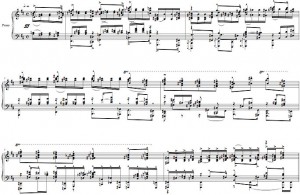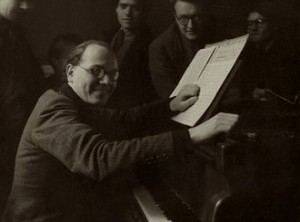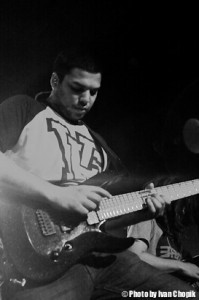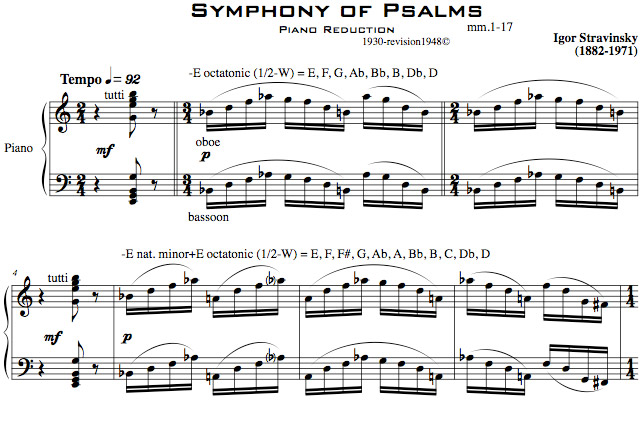
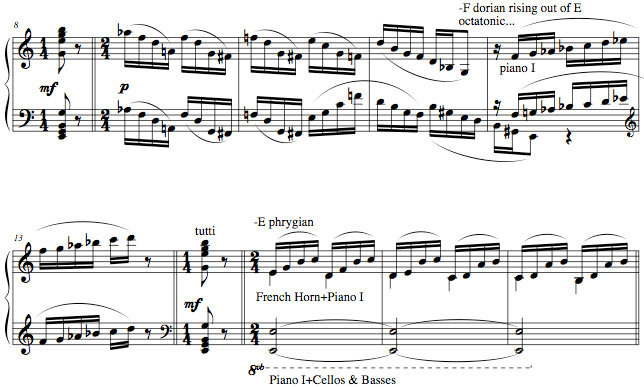 Symphony of Psalms
Symphony of Psalms
Take a look at the first 17 bars that open the work:
Notice that Stravinsky starts the work with a tutti E minor chord. Tutti meaning the whole/majority of the ensemble will help voice the chord; in this case it really is the whole ensemble that plays the said voicing. This has a curious effect, as most listeners will hear what gets played next against that E minor triad even if the chord is no longer ringing. In fact, that is how we perceive it.
Stravinsky follows that triad with arpeggios that come straight out of the E octatonic pitch collection (E,F,G,Ab,Bb,B,Db,D or E ½-W mode); it is actually not all that useful to attach chord symbols to these arpeggio figures because they are non functional, meaning, they do not truly have harmonic function implied in their use.But, you could go ahead and call the 2nd bar a Bb7 chord followed by a G7b9 chord. You can still see though, that both Bb7 and G7b9 are possible harmonizations for the E octatonic (½-W) pitch collection thus why I bring it up, simply to show how Stravinsky is approaching the octatonic scale in the first 3 bars.
He once again then repeats that same E minor triad. It should be noted that the G natural in this particular voicing of Em is rather odd; rarely will composers double the 3rd of a root position triad that much (there are 4 G naturals out of an 8 note voicing.), this will be explained later on. In measure 5-11, Stravinsky continues his small melodic motif of arpeggiating chords, but this time he extends these chords to notes outside of E octatonic (½-W). In fact, this is the beginning of something important in the movement, where Stravinsky begins to imply a dichotomy that will be present in the entire 1st movement of the work, mainly the balance between the diatonic church modes and the octatonic scale.
In this case, we begin to hear E Aeolian creep into the octatonic arpeggios (this scale would be a very large, 11 note hybrid if read in order: E natural minor+ E octatonic [½-W] – E,F,F#,G,G#,A,Bb,B,C,Db,D); of course do not take this to mean this is a quasi-chromatic scale that gets played linearly up and down. Stravinsky never uses it in that way, he simply introduces pitches that will imply E natural minor into his octatonic arpeggios. (eg: F# and A natural sounding within the previous octatonic arpeggio sequence.)
Finally he breaks both the symmetrical dominance of the octatonic scale and the superimposition of E natural minor+ E octatonic (½-W) completely, by writing an F Dorian (F G Ab Bb C D Eb) scale that simply rises step wise out of the ashes of E octatonic (½-W). Once again the whole ensemble punctuates another Em triad followed by a purely diatonic moment, where Stravinsky has the ensemble play inside of E Phrygian; the first real moment where the octatonic scale is suppressed, and an important moment that sets up the listener to clearly hear the balance of the movement between church modes and the octatonic scale.
Notice however, that Stravinsky uses E Phrygian here, whose most important telling interval would be the b2 between root and 2nd degrees (E-F), it is not a surprise that this interval also happens to be inside the E octatonic (½-W) pitch collection that Stravinsky has been working with so far in the 1st movement. This will become rather important as the movement progresses, and it will be made clear that Stravinsky purposely exploited that link between both octatonic and diatonic scales.
Let’s move ahead to mm. 26:
5

Here Stravinsky sets up an ostinato (a repeating rhythmic and/or melodic figure) that is based around the octatonic scale (same pitch set as the E ½-W Octatonic collection). This group is repeated as the choir (in this case just the altos) makes their first appearance.
Take a look at the very simple plainchant that the altos sing (starting on mm.26 as well):
6

Looking back at the entrance of the E Phrygian line we talked about before, it becomes clear that Stravinsky now wants to have the listener hear this plainchant as a quasi-church chant in E Phrygian. The modernity in his approach is to take that very simple minor 2nd plain chant that would have probably been heard as a simple modal melody, and superimpose against it the octatonic ostinato! This is where the piece lives, between church modes and implied “religious chants” and the novel use of the octatonic scale.
Notice once again that both E Phrygian and E (½-W) octatonic both have that E-F interval, which Stravinsky fully exploits in this moment of the piece so that the listener is confronted with a familiar sound (modal plainchant) against a modernist approach to composing (the octatonic ostinato).
Looking at mm.33
7

If you look carefully, this is actually the first time that we hear the octatonic scale fully laid out linearly, in essence all 8 pitches in the same measure or group. One could ask then, if this is the first time we hear it in mm.33, how are we to assume it was ever octatonic up to this point as opposed to a hybrid 7 note scale?
This question is valid, but, I think to put it simply, one is hard pressed to hear 7 notes of a symmetrical scale and then imagine that the 8th note is then NOT part of that said scale. Also, consider that we hear the octatonic parts up until mm.33 as octatonic; this has once again to do with the scale’s symmetrical properties.Also at mm.33 we get the first entrance of the full choir, the climax of the work so far, though that is not to say it is the climax of the 1st movement.
Stravinsky then continues to rely on this continual duality of modal church music against the symmetry and ambiguity of the octatonic scale. The musical effect this produces is extraordinary, and Stravinsky pushes this idea across this short movement up until the very end where the beginning instance of that E minor triad that was punctuated with those G natural doublings that could have been considered rather odd, begin to make sense. Why was Stravinsky giving so much importance to the note G in those constant Em chords? The answer can be seen in the last few bars, when the entire ensemble ends the first movement on a Phrygian half cadence on G major.
8

The real sense of symmetry to the movement can be gathered when one considers that the 2nd movement begins on the note C (it is in fact a double fugue around the tonic note C). This half cadence that ends the first movement not only outlines the important minor 2nd interval found in the octatonic scale which infects the entire movement (notice the Ab-G down a half step resolution that is part of the Phrygian half cadence or better known as Fm/Ab to G or G7), but it also gives a closing significance to the importance of the note G natural in the beginning of the movement. Finally it also sets up a direct link to the 2nd movement fugue, in essence, the 1st movement ends on a V chord to the 2nd movements tonic.
As can be seen, this 1st movement is very well written (as is expected from a composer the level of Stravinsky); the balance is in my opinion perfectly achieved between the church modes and the octatonic scale, the simple plainchants and the modernist octatonic ostinato.
The point of this column of course, is to show how the octatonic scale can be used to create motifs, chords, and essentially control the form of an entire movement of music. I hope it inspires guitarists and composers to look more deeply into the possible music that can be composed out of the octatonic scale (and other non-diatonic pitch sets).
It becomes clear when you listen to a work such as the Symphony of Psalms that a small column like this cannot begin to dive into every aspect of the work; the rhythmic aspects alone could take up a column ten times this size with ease. I urge everyone to grab a copy of this work, and to listen and break down the 2nd and 3rd movements as well; I personally find the 2nd movement to be some of the most inspired music Stravinsky ever wrote.
Make sure to pick up a copy of the Symphony of Psalms, a truly beautiful and masterful work. To read further on Stravinsky look no further than Stephen Walsh’s two book biography on the composer (pick up both books and a copy of the recording at amazon.com)
Sources: Stephen Walsh, Igor Stravinsky.
Roberto’s currently listening to: Ligeti- Requiem




